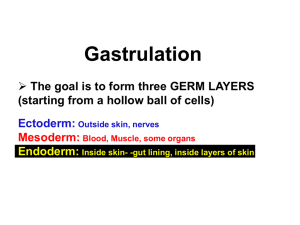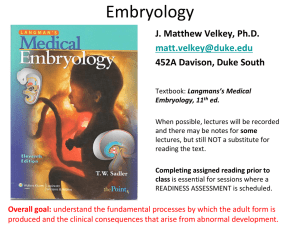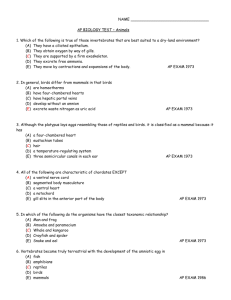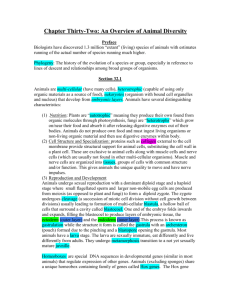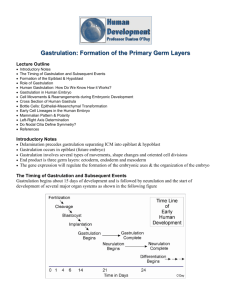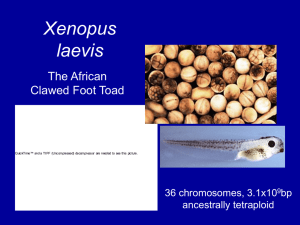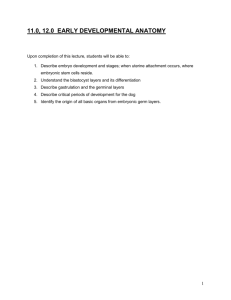Gastrulation COO
advertisement
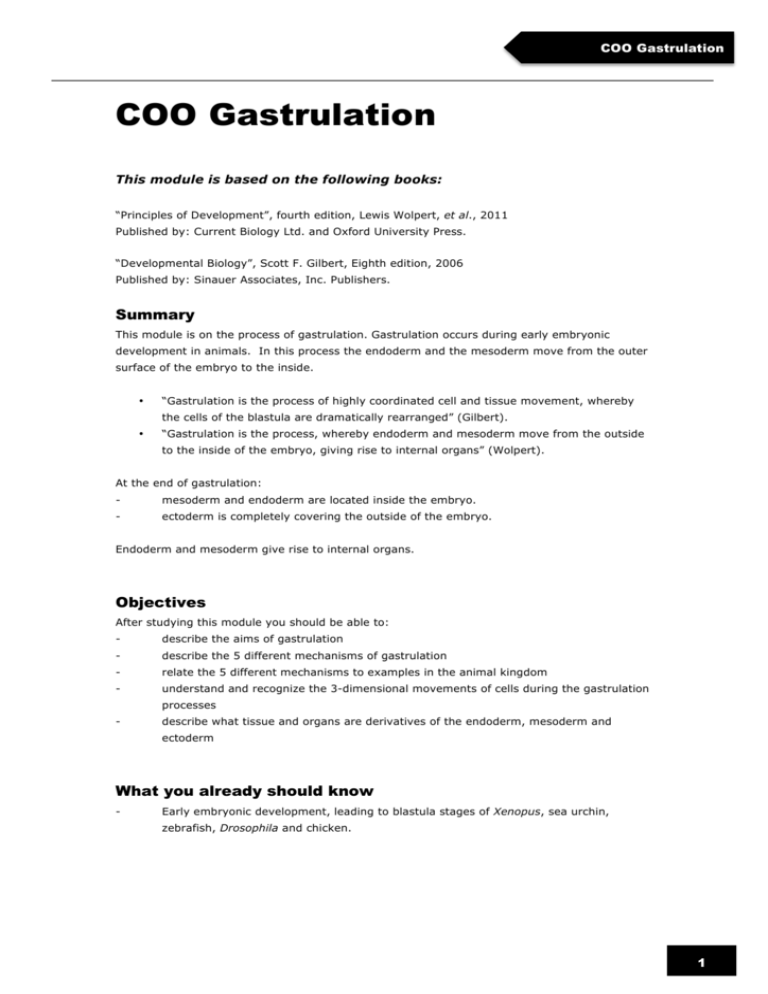
COO Gastrulation COO Gastrulation This module is based on the following books: “Principles of Development”, fourth edition, Lewis Wolpert, et al., 2011 Published by: Current Biology Ltd. and Oxford University Press. “Developmental Biology”, Scott F. Gilbert, Eighth edition, 2006 Published by: Sinauer Associates, Inc. Publishers. Summary This module is on the process of gastrulation. Gastrulation occurs during early embryonic development in animals. In this process the endoderm and the mesoderm move from the outer surface of the embryo to the inside. • “Gastrulation is the process of highly coordinated cell and tissue movement, whereby the cells of the blastula are dramatically rearranged” (Gilbert). • “Gastrulation is the process, whereby endoderm and mesoderm move from the outside to the inside of the embryo, giving rise to internal organs” (Wolpert). At the end of gastrulation: - mesoderm and endoderm are located inside the embryo. - ectoderm is completely covering the outside of the embryo. Endoderm and mesoderm give rise to internal organs. Objectives After studying this module you should be able to: - describe the aims of gastrulation - describe the 5 different mechanisms of gastrulation - relate the 5 different mechanisms to examples in the animal kingdom - understand and recognize the 3-dimensional movements of cells during the gastrulation processes - describe what tissue and organs are derivatives of the endoderm, mesoderm and ectoderm What you already should know - Early embryonic development, leading to blastula stages of Xenopus, sea urchin, zebrafish, Drosophila and chicken. 1 COO Gastrulation Gastrulation Mechanisms Formation of mesoderm Depending on the species, mesoderm is formed either before or during gastrulation. Before gastrulation: For example in the frog (amphibia) the formation of the mesoderm starts around the 64-cell stage. It continues until the onset of gastrulation. During gastrulation: In sea urchins (echinoderms), for example, the formation of mesoderm is part of the gastrulation process. Mechanisms of gastrulation There are 5 different kinds of gastrulation movements. 1) Epiboly: extension of a sheet of cells causing movement of this sheet over presumptive deeper layers 2) Invagination: indentation of a region of cells resulting in the formation of a “dimple” 3) Involution: inward movement of a layer of cells 4) Delamination: splitting of a tissue into 2 or more parallel cellular layers 5) Ingression: migration of individual cells from a surface layer to internal One or more of these mechanisms can be responsible for gastrulation. This depends on the species. 2 COO Gastrulation Convergent extension In most species very extensive cell movements take place during gastrulation. Often cells “crawl” in-between each other (intercalate) and elongate (extend). This process is called convergent extension. Two types of convergent extension are known. 1) Radial intercalation: A double (or multiple) layer of cells intercalate in such a way that a single layer of cells is formed. As a result, the surface of the layer of cells is enlarged. Examples are epiboly in zebrafish and in Xenopus embryos. for example: ectoderm 2) Medio-lateral intercalation: Cells of a single layer intercalate medio-laterally. Due to this type of intercalation, the cells form an elongated structure (e.g. the notochord). for example: endoderm, mesoderm, notochord Echinoderms Sea Urchin: Early blastula Below you see an early blastula stage embryo (left) and its schematic drawing (right). The embryo is a hollow sphere (blastula) with a large cavity, the blastocoel. The cells surrounding the cavity are connected to each other by tight-junctions. These cells form an epithelial layer, called the blastoderm. All cells have cilia on their external surface. Because of ciliary movements the embryo can rotate. The external face of the cells is covered by the hyalin layer. This is a layer of extracellular matrix proteins. At the blastocoelic side, the cells are also covered with a layer of extracellular matrix proteins. This layer is the basal lamina. Sea Urchin: late blastula After the formation of a blastula, the sea urchin embryo flattens and thickens at the vegetal side. This flattening is very well visible and is called the vegetal plate. 3 COO Gastrulation Click on the vegetal plate in the figure on the right. At the animal pole, some cells developed very long cilia. This group of cilia is called the apical tuft. Sea Urchin: fate map A fate map illustrates what the different parts of the embryo will form later in (normal) development. This can be drawn at the late blastula stage. The cells that will later form the mesoderm are all derivatives (descendents) of the micromeres. Remember that in sea urchin embryos the micromeres are located at the vegetal pole. Sea Urchin: onset of gastrulation In the sea urchin the gastrulation starts in the vegetal plate in individual cells. Some cells of the vegetal plate lose their affinity for their neighboring cells and for the hyalin layer. Moreover, their affinity for the basal lamina is increased. These cells change shape and form filopodia. Finally, they leave their epithelial configuration and migrate into the blastocoel. This process is called ingression. 4 COO Gastrulation After ingression, the cells that migrated into the blastocoel are called primary mesenchyme cells (PMC). In normal development about 64 PMCs are formed. All PMCs are derivatives of the micromeres. In the figures you can see both a schematic drawing of ingression and a microscopic photograph of the ingressed PMC. Sea Urchin: migration of PMC After ingression, the PMC move to two ventro-lateral regions in the blastocoel. Here they form calcium carbonate spicules (spines). Click on the two clusters of PMC. The two clusters remain connected by a small row of PMC, called dorsal and ventral chain respectively. The PMC form filopodia with which they “probe” the surrounding cells and the extracellular matrix (ECM). 5 COO Gastrulation Sea Urchin: informational cues for migration After ingression, the PMC migrate towards a specific position inside the blastocoel. Drag the items to their correct position. A few studies indicate that ECM proteins play an important role in defining the direction of migration of the PMC. What do you expect to happen if ECM molecules inside the balstocoel are ‘masked’ with an injection of antibodies against ECM before the onset of gastrulation? Sea Urchin: formation of the archenteron 1 After the ingression of the PMC, the remaining cells of the vegetal plate start to change in shape. Cells flatten and actin filaments that are located at the apical side of some cells constrict. Because of this, a small indentation (dimple) is formed. This marks the onset of the formation of the archenteron (primitive gut). Enter the name of this gastrulation mechanism. The indentation or opening of the archenteron is called the blastopore. The blastopore will form the anus of the adult sea urchin. 6 COO Gastrulation Click on the blastopore of the gastrulation embryo. In animals in which the blastopore forms the anus, the mouth is formed secondarily. These animals are called Deuterostomes. The other animals are called Protostomes. Formation of the blastopore solely results from changes in cell shape due to apical constriction. This is confirmed by computer simulations. Sea Urchin: formation of the archenteron 2 After invagination the archenteron starts to elongate. The endodermal cells lining the archenteron undergo convergent extension by medio-lateral intercalation. This elongates the archenteron tube. How does the process of convergent extension affect the diameter of the archenteron tube? Sea Urchin: formation of the archenteron 3 The onset of the final extension is characterized by yet another ingression of cells, the secondary mesenchyme cells (SMCs). This ingression occurs at the top of the archenteron. The SMCs remain on top of the archenteron. They form long filopodia with which they “probe” the ECM. The filopodia stick to one specific site at the animal side. Specificity for this site is based on differences in affinity to ECM proteins (differential adhesiveness). Once ‘stuck” to this site the filopodia contract. This way the top of the archenteron is pulled up. The archenteron “breaks through” at this site and forms the mouth. 7 COO Gastrulation Sea Urchin: fate of the SMCs After the formation of the mouth, the SMCs disperse into the blastocoel. SMCs form mesodermal organs such as the skeletal rods. Sea Urchin: summary archenteron formation Formation of the archenteron can be divided into three steps. In chronological order, enter the process belonging to each step. 1) 2) 3) After formation of the archenteron the mouth is formed. Sea urchin: summary gastrulation We have discussed the gastrulation of the sea urchin. Which two gastrulation mechanisms are important during sea urchin development? Amphibian Xenopus: fertilization The spermium enters at the animal half (hemisphere) of the oocyte. The point of entrance is 8 COO Gastrulation called the ‘sperm entry point” (SEP). The side where the SEP is located is the future ventral side of the animal. The opposite side is the future dorsal side. Mark the dorsal and ventral side of the embryo. The first cleavage is through the SEP and the future dorsal side. It divides the embryo in a left and right side. Gastrulation starts at the opposite side of the SEP, just below the position of the future Spemann organizer. Read Wolpert, pages 132 and 344-346 for more information on fertilization and: - cortical reaction - cortical rotation Read Wolpert, pages 98, 130-133 and 156-161 for more information about the Spemann organizer. Xenopus: gastrulation In Xenopus embryos, the presumptive endoderm is located in the vegetal hemisphere. These cells are rich in yolk. Yolk is used as “food” by the developing embryo. Drag the items to their correct position. At the onset of gastrulation, the already induced mesoderm is located in the equatorial zone. This zone is called the marginal zone. During gastrulation, the endoderm and mesoderm become located inside the embryo. 9 COO Gastrulation After gastrulation, the outside of the embryo is completely covered with ectoderm. Xenopus: onset of gastrulation Gastrulation starts with an invagination. This invagination is located at the dorsal side of the embryo, just vegetal from the marginal region, vegetal from the Spemann Organizer. The invagination is driven by bottle-shaped cells inside the embryo. Enter the name of the “dimple” resulting from invagination. Invagination is followed by inward movement of cells. What is the name of this gastrulation mechanism? The dorsal mesoderm converges and extends by medio-lateral intercalation. Later on, this dorsal mesoderm will form the notochord. After gastrulation, the ectodermal cells cover the surface. The enlargement of the outer surface is caused by radial intercalation. Enter the name of this gastrulation mechanism. The figure below shows the vegetal view of a Xenopus embryo. At this stage involution just started at the dorsal side of the embryo. 10 COO Gastrulation Click on the following part of the embryo: A: endoderm B: ectoderm C: dorsal lip The involution that started at the dorsal side extends laterally. Finally it starts at the ventral side. This way a complete ring of involuting cells is seen. Xenopus: gastrulation The figure below shows a cross section of a gastrula stage Xenopus embryo. Drag the following items to their correct position. 11 COO Gastrulation The pictures below show the tissue movements that take place during gastrulation of Xenopus. They are, however, not in the correct sequence. Drag the pictures to the table below and put them in the correct order, starting from the beginning of gastrulation. In which pictures is the blastocoel visible? In which pictures is the archenteron visible? 12 COO Gastrulation The figure below shows a cross section of a gastrula stage Xenopus embryo. Drag the following items to their correct position. We have discussed Xenopus gastrulation. Which three gastrulation processes are important in Xenopus? 1) 2) 3) Fish Zebrafish: early development In the figure above you see the early cleavages of the zebrafish embryo. The first cleavages occur every 15 min. These cleavages are confined to the animal half of the embryo. In this way a mound of cells is formed that sits on top of a large yolk cell. At the 10th cell cycle, the blastoderm can be divided into two layers of cells: - the outer enveloping cells and - the deep cells. 13 COO Gastrulation Until the 10th cell cycle, the blastomeres remain on top of the yolk cell and divide synchronously. Zebrafish: onset of gastrulation After the 10th cell cycle, the division of cells becomes asynchronous and the cells begin to move. The first cell movement is the movement of cells over the yolk cell. How is this process called? Once cell movement has reached about 50% of the diameter of the embryo, a thickening occurs at the entire margin of the blastoderm. This thickening is called the germ ring. At the germ ring, the presumptive endodermal and mesodermal cells turn inwards. What is the name of this process? The endodermal and mesodermal cells are derivatives of the deep layer. Due to involution, the deep cells form two layers of cells: - an outer layer called epiblast, - an involuted layer called hypoblast. 14 COO Gastrulation The envelope layer lays on top of the epiblast. The epiblast forms the outer epithelium and the neural tissue. The hypoblast forms the chordamesoderm and the adjacent mesodermal structures. Zebrafish: the embryonic shield At the future dorsal side of the embryo a localized thickening is formed: the embryonic shield. This shield is functionally equivalent to the dorsal involuting cells of the Xenopus embryo (the Spemann organizer). The hypoblast cells that involute at the dorsal side converge anteriorly and dorsally and extend in anterior direction. This type of cell movement is known as… The hypoblast cells form the chordamesoderm, the primordium of the notochord. Convergent extension can be shown by visualizing cells that express the gene no tail. No tail is expressed in presumptive notochord cells. In the figures you see no tail-expressing cells in two different stages of gastrulation. 15 COO Gastrulation In the figure below, epiboly has reached about 50% of the diameter of the embryo. Enter the names of the specified structures. We have discussed zebrafish gastrulation. Which two gastrulation mechanisms are important during zebrafish development? 1) 2) Insects Drosophila: early development Drosophila embryos undergo superficial cleavages. This way many nuclei are formed within a single cell. At 256 nuclei, the nuclei migrate to the periphery of the embryo. The embryo is now called a syncytial blastoderm. At 1024 nuclei, the outer membrane of the embryo folds inwards between the nuclei. Eventually, each somatic nucleus becomes localized in a single cell. Now the cells are arranged into a single-layered jacket around the yolky core of the egg. This is called the cellular blastoderm stage. Drosophila: gastrulation At the ventral side, by invagination an indentation is formed along the anterior-posterior midline. This indentation is called the ventral furrow. Enter the name of the gastrulation mechanism leading to the formation of the ventral furrow. 16 COO Gastrulation In the ventral furrow, the presumptive mesodermal cells move inward. Which gastrulation mechanism is responsible for the inward movement of cells in Drosophila? This process can be visualized by following twist expression. The twist gene is expressed in all presumptive mesodermal cells. Within 30 min., all presumptive mesodermal cells have moved inside the embryo. The figure below shows a lateral view of the Drosophila embryo. Gastrulation begins when the presumptive mesoderm invaginates in the ventral region. First the ventral furrow is formed. Then an internalized tube is formed. Cells leave the tube and migrate under the ectoderm. Later they form the mesodermal organs. We have discussed Drosophila gastrulation. Which two gastrulation mechanisms are important during Drosophila development? 1) 2) Chick Chick: early cleavages The early cleavages in the chick embryo create a blastodisc (= blastoderm) above the enormous yolk cell. As cleavages continue, the central cells of the blastodisc become separated from the yolk cell by the subgerminal cavity. The cells above the subgerminal cavity appear clear and therefore this area is called the area pellucida (pellucidus = transparant). The cells at the margin of the area pellucida appear unclear and are called the area opaca (area opaque; opacus = nontransparant). 17 COO Gastrulation Chick: onset of gastrulation From the area pellucida individual cells move into the subgerminal cavity. How is this gastrulation mechanism called? They form small islets of cells called the polyinvagination islands. These islets form the primary hypoblast. At the posterior margin of the blastoderm a group of cells called the secondary hypoblast cells or endoblast cells migrates into anterior direction. As they migrate they incorporate the polyinvagination islands of the primary hypoblast. The resulting layer consist of is both primary and secondary hypoblast cells. Now the blastoderm consists of two layers: - the epiblast, and the layer with primary and secondary hypoblast cells The primary and secondary hypoblast cells do not contribute to the embryo proper. Later in development these cells are replaced by (definitive) endodermal cells. Chick: the primitive streak As the hypoblast moves anteriorly, some cells at the posterior side in the epiblast thicken. This thickened area is the (early) primitive streak. Thickening is caused by: - ingression of mesodermal cells from the epiblast into the blastocoel, and - migration of cells from the lateral regions of the posterior epiblast towards the center. The thickening narrows and moves anteriorly to form the definitive primitive streak. 18 COO Gastrulation The primitive streak moves anteriorly (progression). It marks the anterior-posterior axis. At the anterior end of the primitive streak a regional thickening is seen. This thickening is called Hensen’s node. Having reached 60-75% of the length of the area pellucida, the primitive streak regresses toward the posterior end. Drag the following items to their correct position. Chick: cell movement in the primitive streak During the progression of the primitive streak, cells migrate through: - Hensen’s node, and - the primitive streak Cells that move through Hensen’s node migrate anteriorly. They form the “anlage” of the foregut, head-mesoderm and the notochord. Cells that move through the primitive streak form the majority of the endoderm and mesoderm. The presumptive endodermal cells move deeper than the presumptive mesodermal cells. They displace the hypoblast cells to the sides. They form the endoderm and most of the external membranes. The rest of the external membranes is formed by the hypoblast. 19 COO Gastrulation All cell movements through Hensen’s node and the primitive streak are movements of individual cells, not of a sheet of cells like in Xenopus. The primitive streak of chick is functionally equivalent to a structure in Xenopus and in zebrafish. In these structures (presumptive) mesodermal cells migrate into the blastocoel. Which structure in Xenopus and zebrafish are we referring to? Xenopus: Zebrafish: Overview Which of the gastrulation processes are important during development of each of the following animals? 20

